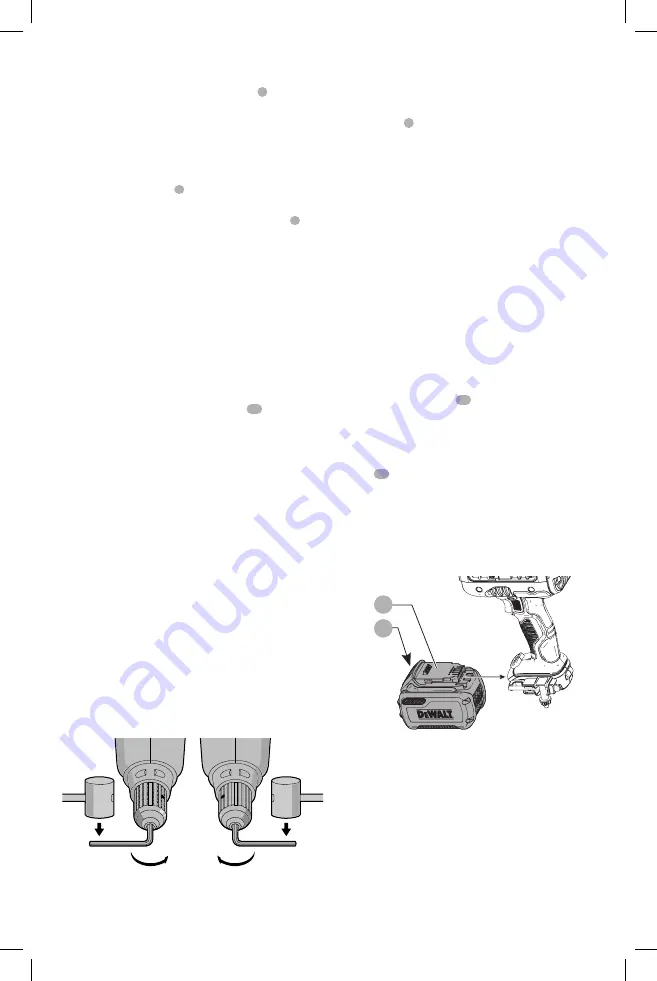
English
9
Variable Speed Trigger Switch (Fig. A)
Depressing the variable speed trigger switch
4
turns the
tool on, releasing the variable speed trigger switch turns
the tool off. The variable speed trigger switch permits speed
control—the farther the trigger is depressed, the higher the
speed of the drill.
Forward/Reverse Button (Fig. A)
A forward/reverse button
3
determines the direction of the
tool. It is located in front of the trigger switch.
To select forward rotation, release the trigger switch
4
and
depress the forward/reverse button on the right side of the
tool.
To select reverse, depress the forward/reverse button on
the left side of the tool. When changing the position of the
button, be sure the trigger is released.
nOTE:
The first time the tool is run after changing the
direction of rotation, you may hear a click on start up. This is
normal and does not indicate a problem.
Keyed Chuck
Open the chuck jaws by turning collar by hand and insert
the shank of the bit about 3/4" (19 mm) into chuck. Tighten
the chuck collar by hand. Place chuck key (
10
, Fig. A) in
each of the three holes, and tighten in clockwise direction.
It’s important to tighten chuck with all three holes. To
release the bit, turn the chuck counterclockwise in just one
hole, then loosen the chuck by hand.
nOTE:
When using hex shank or three-sided shank bits, be
sure to align the flat sides of the bit with the chuck jaws to
ensure the bit is properly engaged by the jaws.
Removal of Keyed Chuck (Fig. G)
Remove the left-handed chuck screw using a T25 torx
wrench, rotating clockwise to loosen.Tighten the chuck
around the shorter end of a hex wrench (not supplied)
of 3/8" (10 mm) size. With the tool braced securely, use
a soft hammer and strike the hex wrench sharply in the
counterclockwise direction when viewed from the front
of the tool. This will loosen the chuck so that it can be
removed by hand.
Keyed Chuck Installation (Fig. H)
Screw the chuck on by hand as far as it will go. Insert the
shorter end of a hex wrench (not supplied) of 3/8" (10 mm)
size and strike it in the clockwise direction with a soft
hammer. Reinstall the left handed clutch screw.
FIG. H
FIG. G
Worklight (Fig. A)
CAUTION: Do not stare into worklight.
Serious eye
injury could result.
The worklight
9
is located on the foot of the tool. The
worklight is activated when the trigger switch is depressed,
and will automatically turn off 20 seconds after the trigger
switch is released. If the trigger switch remains depressed,
the worklight will remain on.
nOTE:
The worklight is for lighting the immediate work
surface and is not intended to be used as a flashlight.
OPERATION
WARNING: To reduce the risk of serious personal
injury, turn unit off and remove the battery pack
before making any adjustments or removing/
installing attachments or accessories.
An
accidental start-up can cause injury.
Installing and Removing the Battery Pack
(Fig. I)
nOTE:
For best results, make sure your battery pack is
fully charged.
To install the battery pack
12
into the tool handle, align the
battery pack with the rails inside the tool’s handle and slide
it into the handle until the battery pack is firmly seated in
the tool and ensure that it does not disengage.
To remove the battery pack from the tool, press the release
button
13
and firmly pull the battery pack out of the tool
handle. Insert it into the charger as described in the charger
section of this manual.
Squeeze the tool trigger for three seconds to dissipate
the slight electric charge that may still be in the tool. The
worklight may come on for a brief moment.
Fig. I
13
12
Proper Hand Position (Fig. J)
WARNING:
To reduce the risk of serious personal injury,
ALWAYS
use proper hand position as shown.
WARNING:
To reduce the risk of serious personal injury,
ALWAYS
hold securely in anticipation of a sudden
reaction.
Always
hold tool firmly with both hands in the proper
position for operation as shown.






























